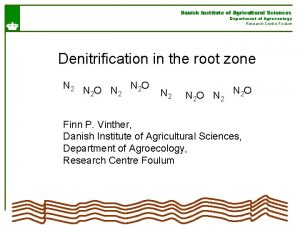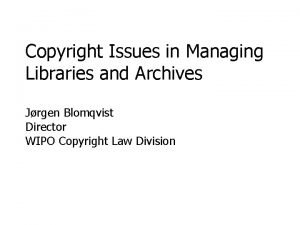Danish Institute of Agricultural Sciences Archived at http

- Slides: 1

Danish Institute of Agricultural Sciences Archived at http: //orgprints. org/00001415 Properties of gluten from organic wheat measured by oscillation Lene Pedersen , Ingrid Kaag Thomsen 1 2 1 Dep. of Food Science, Danish Institute of Agricultural Sciences, Research Centre Aarslev, DK-5792 Aarslev 2 Dep. of Crop Physiology, Danish Institute of Agricultural Sciences, Research Centre Foulum, DK-8830 Tjele E-Mail: Lene. Pedersen@agrsci. dk Introduction The bread making potential of wheat flour is largely related to the gluten proteins. It has until now been stated that the genotype (cultivar) is mainly determining the gluten properties and protein composition, whereas environmental factor like fertilisation has a great impact on the quantity of gluten proteins (Daniel and Triboi, 2000). In organic farming, there seems to be a stronger interaction between genotype and environment on the gluten properties and the baking quality, due to the restricted nutrient availability. Therefore, the influence of nutritional factors must be investigated in order to grow organic bread wheat with suitable baking quality. Rheological characterisation of the viscoelastic properties gluten protein network is essential to explain differences due to genotype and/or environmental factors. The dynamic rheological parameters (G', G'', and ) differ between cultivars with good and poor bread making quality, and differences are mainly related to the ratio between the gliadins and glutenins (Khatkar et al. , 2002). Results Frequency sweeps showed that in the gluten elastic behaviour is dominating (Fig. 1). The moduli G' and G'' increased for increasing frequency. The increase in showed that the viscous properties contributes more at higher frequencies. Increasing levels of N increased the gluten content of the flour (Fig. 2. ). Application of liquid manure resulted in higher gluten contents at all N-levels. The moduli seemed to be influenced by the type of manure, and by the level of N (Fig. 3. ). There was a increase in G' and G'' when N-level was increased from 0 to 75 kg N/Ha for liquid manure (FG), and similar for the slurry (GY) between 75 and 150 kg N/Ha. N-levels beyond these values decreased G' and G''. At the lowest N-level (75 kg N/Ha), G' and G'‘ was higher for the liquid manure (FG). The N-level had no effect on for the slurry, whereas a small increase in was observed for the liquid manure. These results indicate that the type and level of manure affecting the viscoelastic properties of gluten, and the variability in the moduli is probably explained by differences in the protein composition, and mainly gliadins/glutenins (Khatkar et. al. , 2002). Figure 1. Frequency sweep of gluten from two N-levels. Experiments At The Askov Long-term Experiments on Animal Manure and Mineral Fertilizer, an organic farming workshop was established in 1996 with the aim to study the influence of the nutrients. Three nutrients levels are compared with unmanured treatments. The spring wheat cultivar Vinjett was grown with application of two organic manures, slurry (GY) and liquid manure (FG), in three Nlevels (0, 75, and 150 kg N/Ha). Additionally, FG was added at 225 kg N/Ha. Wheat grain was milled, and the gluten was isolated (ICC standard 137). The gluten was measured in oscillation in a frequency range of 0. 05 Hz to 20 Hz. The stress amplitude was 100 Pa. Figure 3. Effect of N-level on G', G'', and δ of gluten. Conclusions Oscillatory measurements of gluten from a field trial with different application of manures indicated that type of manure, and the level of N influenced the viscoelastic properties of gluten. Thus, measurements of G', G'‘, and may be valid in the studies of the influence of growth conditions on the baking quality of wheat. References Figure 2. Effect of N-level on gluten content of flour. Daniel, C. and Triboi, E. 2000. Effects of temperature and nitrogen nutrition on the grain composition of winter wheat: Effects on gliadin content and composition. Journal of Cereal Science 32 45 -56. Khatkar, B. S. , Fido, R. J. , Tatham, A. S. and Schofield, J. D. 2002. Functional properties of wheat gliadins. II. Effects on dynamic rheological properties of wheat gluten. Journal of Cereal Science 35 307 -313

